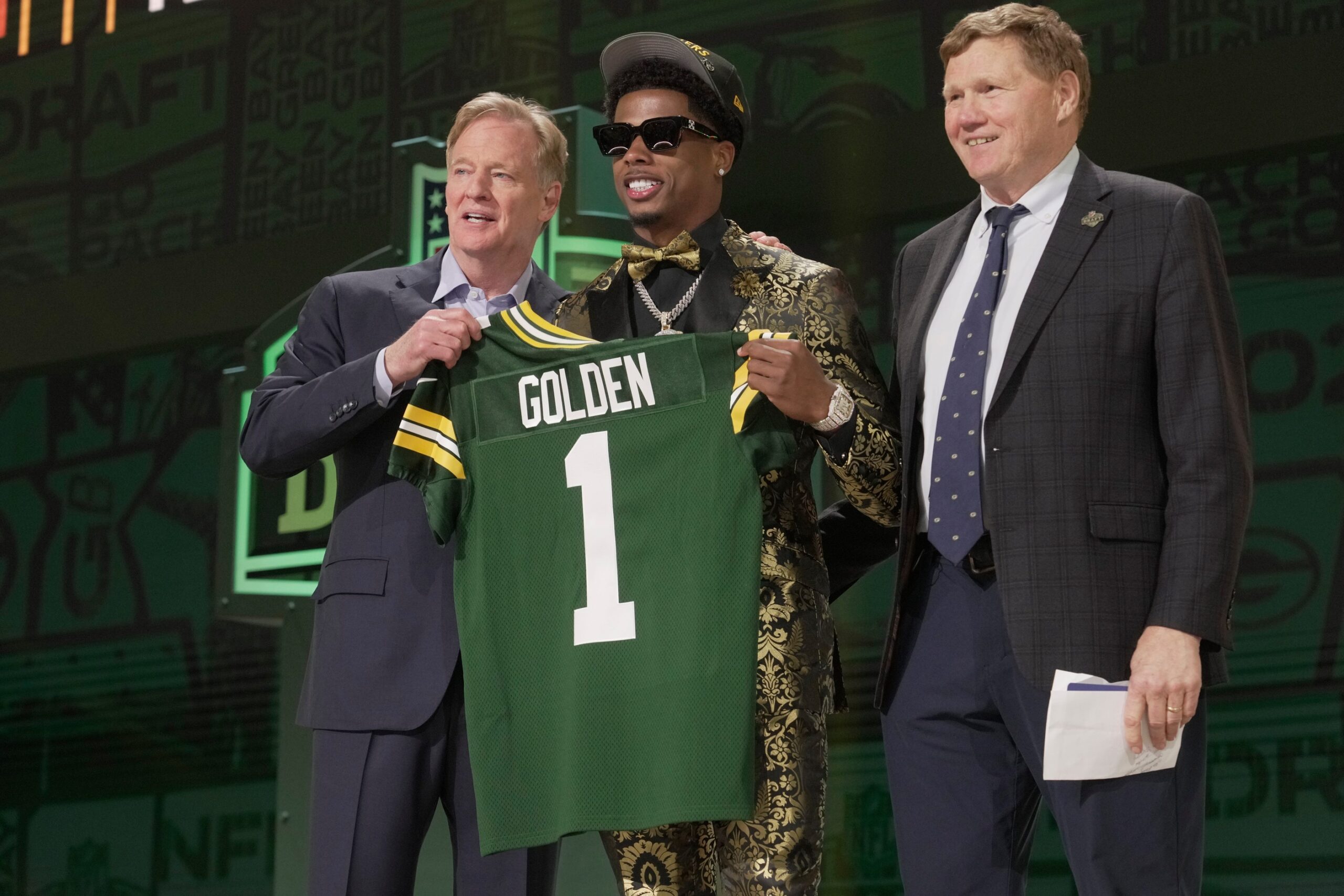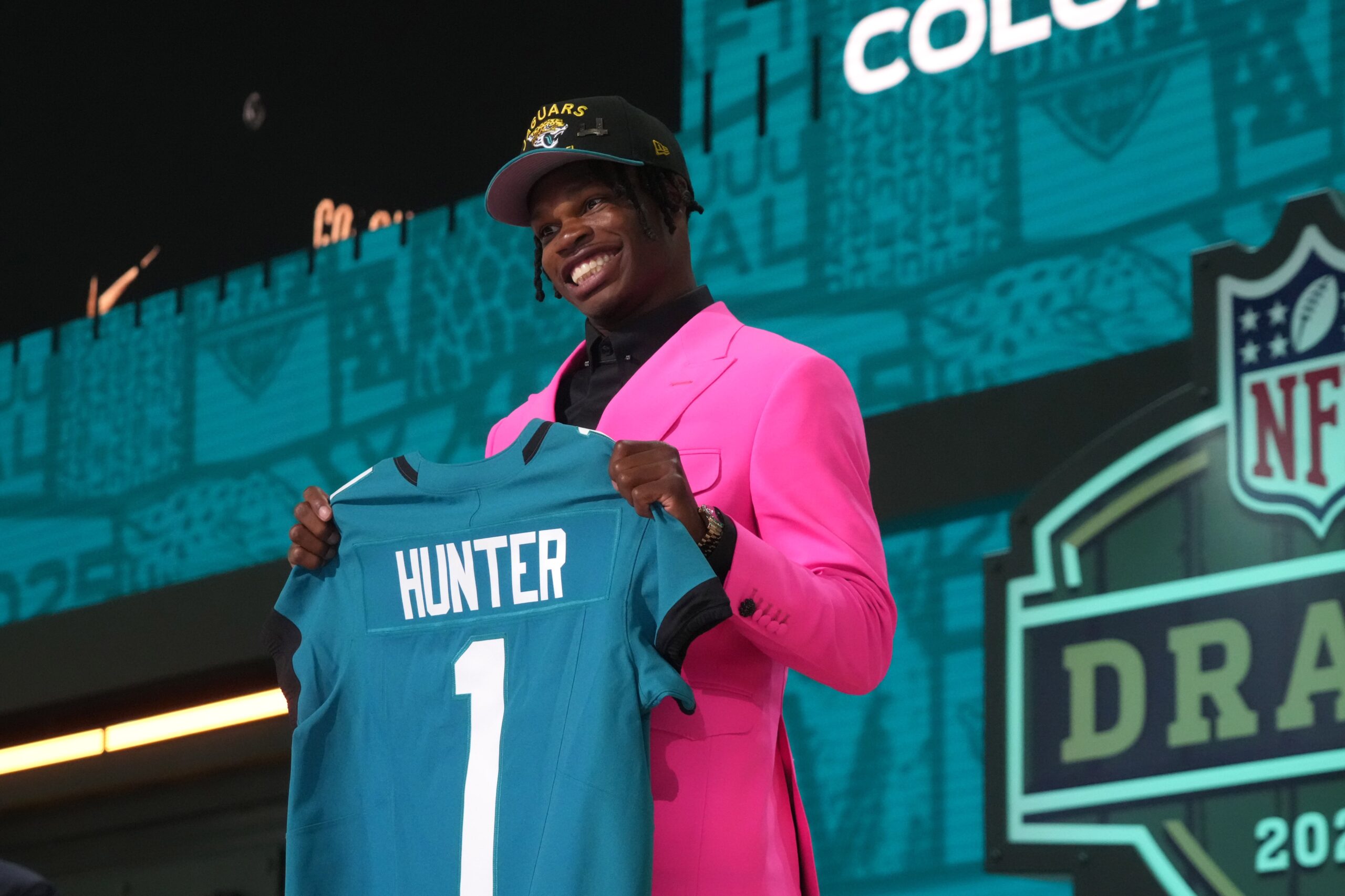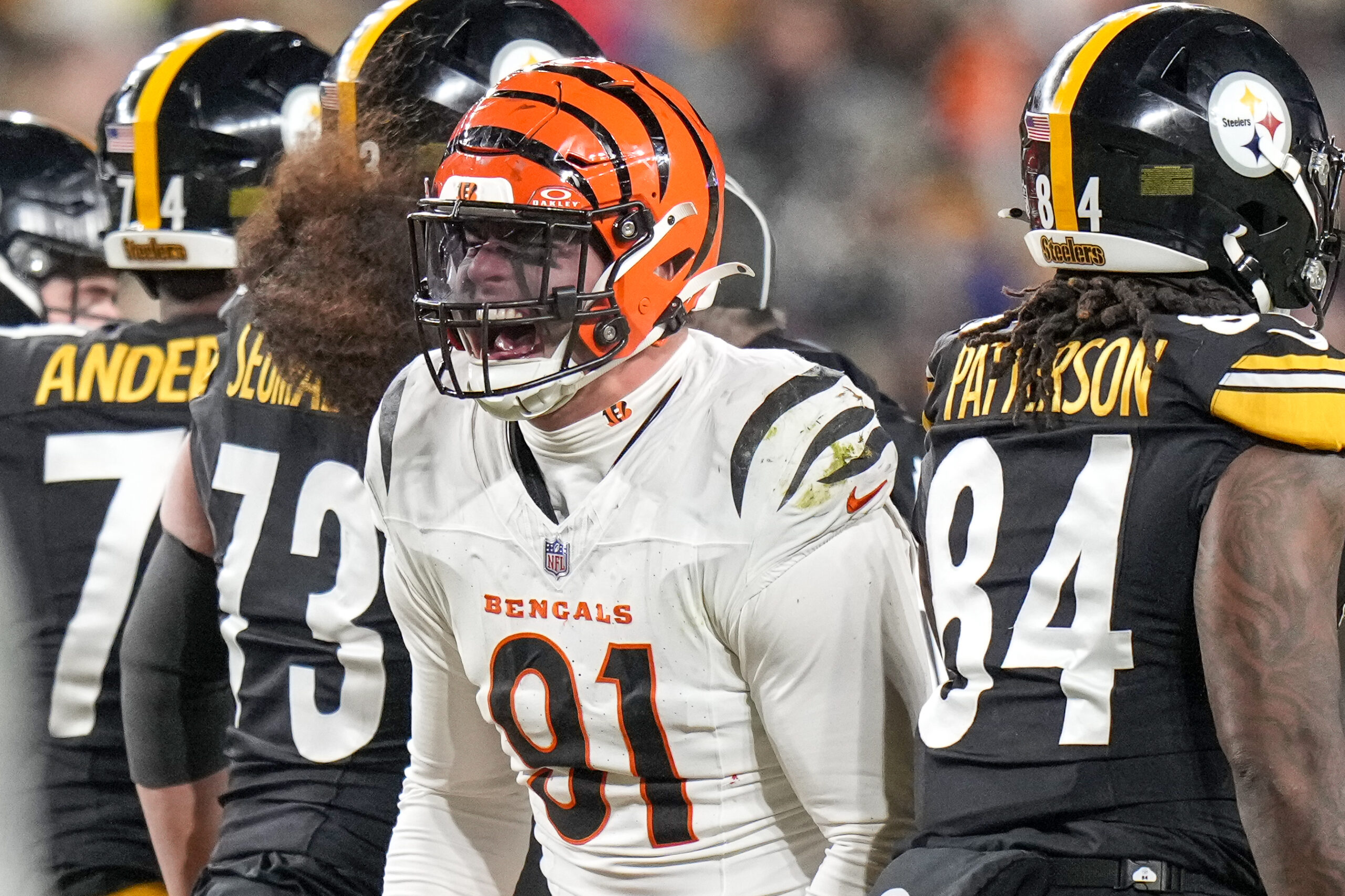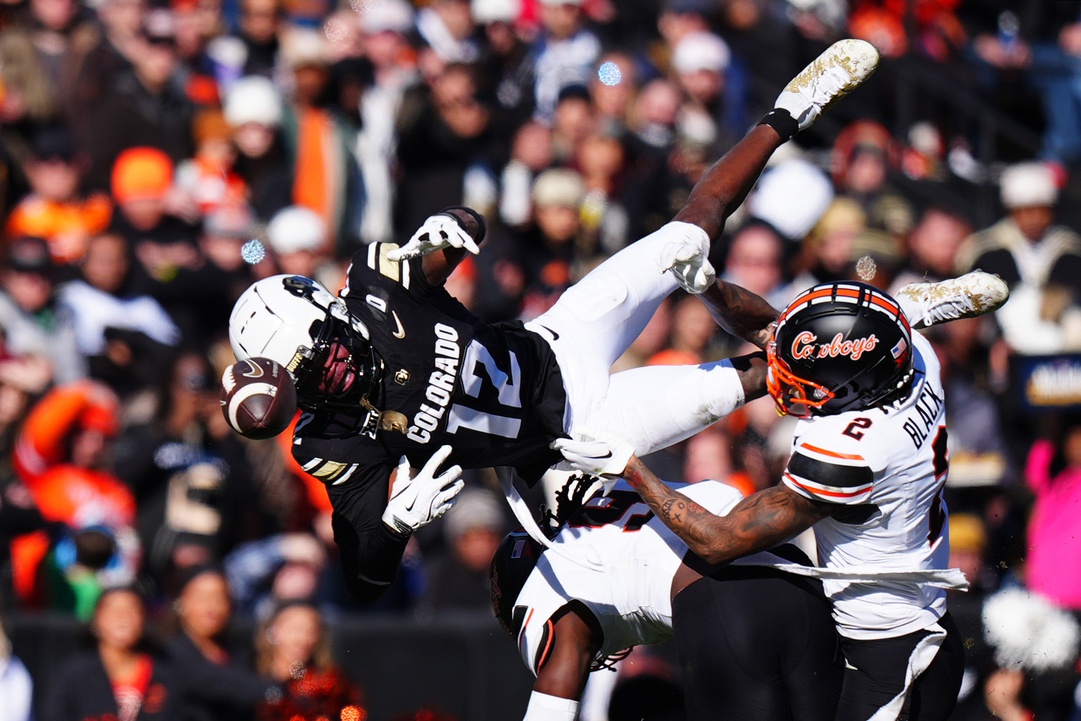Expert Analysis
10/25/24
13 min read
Four Ups, Four Downs: Hopkins, Bowers, Harrison Jr. and More

Welcome to Four Ups and Four Downs, our new weekly column diving into the good (ups) and bad (downs) around the league. This week we’ll talk about some trades, rookie receiver usage, and more.
⬆️Up: The Idea of Power Slot DeAndre Hopkins
The DeAndre Hopkins trade to the Kansas City Chiefs gives the reigning back-to-back Super Bowl champions the best outside receiver and ball-winner that they’ve had on the roster with Patrick Mahomes. It gives an element of a bigger body — though it should be noted that Hopkins is only 6-foot-1 but plays about a foot bigger — that gives the Chiefs a legitimate threat to every level of the field on the outside.
For a conditional 2025 fifth-round pick, it’s more than worth it for adding the receiver Hopkins has been this year.
But what I’m more interested in is the potential increased usage of Hopkins in the slot. Through his years in Arizona, Hopkins was strictly a receiver lined up on the outside left because no one moved in that offense. But there was some sign of what he could do inside when he got the chance.
In 2023, when Hopkins went to Tennessee, there was a slight increase in slot usage, and that’s arguably where he was his most impressive. Hopkins lined up in the slot on 19 percent of his snaps in 2023 and averaged 2.42 yards per route run from the slot. But with the signings of Calvin Ridley and Tyler Boyd this offseason, the Titans hadn’t used Hopkins in the slot as often, just 14 percent of his snaps.
Any team wanting to get the most out of Hopkins is going to want him to do his thing on the outside, but as Hopkins gets a bit older — he turned 32 years old in June — getting him inside and matched up on linebackers or smaller slot defenders could be a huge new advantage.
Think about some of the spacing Rashee Rice was getting in the middle of the field. Hopkins might not have the same juice after the catch, but he’s more than capable of using his body control to win in the middle of the field and take advantage of that space.
We know what Hopkins can be, but how differently the Chiefs use their new receiver could determine how big the impact of this trade will be this season.

⬇️Down: Marvin Harrison Jr.’s Route Tree
Through the first seven weeks of the season, Marvin Harrison Jr. is fourth among rookie wide receivers in receiving yards. It’s not a shame to be behind the likes of Brian Thomas Jr., Malik Nabers, and Keon Coleman, but the way the fourth overall pick and first receive taken in April’s draft has gotten there has been disappointing.
We’ve already lived multiple lives in the Marvin Harrison Jr. discourse this season. It started with the GPS tracking speed in Week 1 and now we’re into his usage and deployment in the offense. There’s a much better cause for concern in the latter for the former.
Arizona has lined Harrison up on the outside for 83 percent of his snaps this season and he’s been used as the vertical threat on the outside. So far, 28.6 percent of his routes have been go routes — just sending him down the sideline. Those haven’t been particularly efficient so far this season and that’s not great at that volume. Overall, a combined 54.8 percent of Harrison’s routes this season have been go’s or hitches.
He’s running go routes at almost double the rate of other rookie receivers like Thomas and Nabers.

Part of the issue is the current environment in Arizona, where the Cardinals are rightfully riding with heavier personnel packages. Just 69.2 percent of Harrison Jr.’s routes have come in 11 personnel, which is higher than only Xavier Worthy among rookies with at least 100 routes and Worthy is supposed to be that vertical outside threat like that.
That personnel does play a part in some of these targets. Harrison Jr. has run some crossers off play-action and has been open, but when Kyler Murray turns back around after the fake, Trey McBride is also wide open in the flat with room to run. It’s not the wrong throw, but it does not use the strengths of the No. 1 receiver.
Defenses have been playing Harrison Jr. like he’s a true No. 1 but the Cardinals haven’t been treating him that way in his own offense. There’s a disconnect that should hopefully be worked out soon.

⬆️Up: Brock Bowers Usage
The Las Vegas Raiders have not done a lot right this season, especially on offense. The quarterback situation is a mess. Davante Adams was traded. The run game is the league’s worst by a mile.
One thing they have gotten right? Brock Bowers. Specifically, the Raiders have crushed Bowere’s usage so far this season. Motioning a tight end from one side of the field to the outside receiver in a trips bunch on the other, then getting him on a whip route against a corner to create space for a bunch of yards after the catch? Yea, that’s pretty freaking cool.
The Raiders haven't done a lot of things well this season but one thing they've figured out is creatively getting Brock Bowers the ball pic.twitter.com/Bg4yPimDc4
— Dan Pizzuta (@DanPizzuta) October 24, 2024
So far this season, Bowers has lined up in the slot for 48.9 percent of his snaps, inline for 35.4 percent, and out wide for 14.5 percent. As expected, he’s done most of his receiving work from the slot, but he’s just averaging 1.8 yards per route run from there. That’s the lowest of his alignments but it’s more than passable for the bigger plays he’s able to create when he lines up as a traditional tight end (3.47 YPRR) and outside (2.42).
Bowers has been in motion on 56 routes, per Next Gen Stats, which is the third-most for a player this season.
Without Davante Adams on the field, Bowers has a 30.6 percent target share and 2.46 yards per route run. He’s already 13th in yards per route run (2.26) among players with at lest 100 routes on the season.
He’s now firmly the Raiders’ top receiving option and could continue to carry that efficiency while he’s peppered with more targets because there’s not a great way for opposing defenses to cover him.

⬇️Down: Eagles Opening Drives
Somehow, the Philadelphia Eagles are the only team in the NFL without an opening drive point through the first seven weeks of the season. Five other teams haven’t scored a touchdown on an opening drive but the Seahawks, Bears, Dolphins, Jaguars, and Jets have at least kicked a field goal.
It’s not just that the Eagles have failed to score on opening drives; they’ve barely come close. During the Eagles’ run to the Super Bowl two seasons ago, they were the best opening-drive team, fueled by aggressiveness and fourth-down conversions, which often led to the end zone.
Every stat one could pull out for Philadelphia’s opening drives makes them look worse than the last. No points would obviously be bad enough, but the Eagles have punted on 83.3 percent on their opening drives. The drive the Eagles didn’t punt? Week 1 when Jalen Hurts was intercepted by Xavier McKinney. Only the Patriots have a higher rate of punts (85.7 percent) but even they scored a touchdown.
It’s difficult to fully analyze the Eagles’ struggles on opening drives because they don’t last that long. Philly has averaged 3.33 plays per drive and 4.8 yards per drive on its first possessions this season—four point eight. The next worst team, the Jets, has averaged 4.57 plays and 13.6 yards per drive.
The most plays the Eagles have run on an opening drive this season is four. Every other team in the league has at least two opening drives with five or more plays.
When there’s been a successful play, it’s been hitting an open receiver in the middle of the field but there are few of those, obviously, with pressure and negative runs often derailing the drives.

⬆️Up: Baltimore's 22 Personnel
One of the great things about the Baltimore offense this season is how many different looks it can give out in a game while doing whatever the offense wants from them. The Ravens have such an advantage in personnel because so many of their players are versatile. That’s so clear when they go into 22 personnel (two backs and two tight ends).
The Ravens have used 22 personnel on a league-leading 16.8 percent of their offensive snaps this season. On those plays, they’re averaging 7.4 yards per play and 0.20 EPA per play. It’s an effective personnel grouping to run and pass. That’s what makes it so dangerous.
Patrick Ricard is the second back in these looks, and he can line up as a fullback, tight end, or basically be used as a sixth offensive lineman. He’s the key to most of these looks. Because of how much he moves around, there’s no tell for what the Ravens are going to do on a given play.
Baltimore has only passed 21 percent of the time from 22 personnel, but they’ve been effective enough on the ground that defenses have to respect the big bodies coming at them with Derrick Henry or Lamar Jackson a threat to carry the ball. The Ravens have averaged 0.10 EPA per play on runs from 22 personnel, insane efficiency with an 80 percent run rate.
With that focus on the run, the pass has opened up in a big way. Watch this screen to Zay Flowers from Monday night against Tampa Bay. The Ravens faked a toss to Henry and the entire defense flowed to the run action. Flowers set up for the screen while Ronnie Stanley snuck out to get in front of him.
— Dan Pizzuta (@DanPizzuta) October 25, 2024
We’ll see more of this and more big plays throughout the season.

⬇️Down: Wan’Dale Robinson’s Target Share
Wan’Dale Robinson is a fun player. The 5–foot-8 former second-round pick has wiggle and speed to be a weapon in the open field. He, however, should not be the centerpiece of an offense.
He’s not technically that for the New York Giants because Malik Nabers is the top receiving option for the offense but Robinson is currently fourth among all receivers in target share at 29.1 percent.
Part of that is due to the two games Nabers missed because of a concussion — and even with those two games missed, Nabers is ninth in target share at 26.1 percent — but even when Nabers was on the field, Robinson had a significant role in the passing game, especially on third downs.
Robinson has been targeted on 44.6 percent of the Giants’ third down passes, easily the highest rate in the league. George Pickens is second at 38.2 percent. But just 27.6 percent of those targets have seen a success by EPA. That’s quite the drop-off.
There’s a line between how Robinson can be used efficiently and what the Giants are trying to get out of him. A lack of receiving talent is certainly part of the issue here but it’s not so much of a gap that the smallest receiver on the team should be seeing almost half of the third down targets.
Darius Slayton has been useful his whole career, even when the Giants don’t want him to be. Jaylin Hyatt has juice but the Giants don’t put him on the field. These are great answers, but a sub-30 percent success rate on over 40 percent of third down attempts also seems less than ideal.
This feels like an indictment of the players, the quarterback, and the play-caller for not having something better going in these high-leverage situations. This isn’t the biggest problem the Giants face, but it does help explain some of the others.

⬆️Up: Ernest Jones in Seattle
The Seattle Seahawks needed a linebacker. Their duo of Tyrel Dodson and Jerome Baker just wasn’t working. Both had the traits of athletic, rangy linebackers but the run fits weren’t fitting. With the Titans in sell mode after 1-5 start, the Seahawks acquired linebacker Ernest Jones, who Tennessee had acquired in a trade with the Rams right before the season started.
Jones, who we pegged as one of the league’s most underrated players, should be a perfect fit in this Seattle defense. The expectation is that Jones will play the Mike as Dodson will slide out of the middle of the field, a move that should benefit all involved.
Throughout his career, Jones has been one of the better run-defending linebackers. This season, 63.6 percent of Jones’s tackles have produced positive EPA for the defense. That rate is the sixth-highest among 77 defenders with at least 40 tackles this season.
Jones can cover, while doing so from the line of scrimmage, and has been an effective blitzer throughout his career, increasing that rate and role each season he was with the Rams. He gives more juice in those mugged-up pre-snap looks and sim pressures because he can be a legitimate threat as a pass rusher but can also handle dropping back into coverage.
By coming from Tennessee under Dennard Wilson, he already got a taste of a Mike Macdonald system. This could be a great buy-low fit for a defense that has desperately needed a better presence in the middle.

⬇️Down: Houston’s First Down Stuffs
Harping on Houston’s early-down offense has been common, especially if you read 1st & 10 every week. It’s one thing to have an inefficient run-heavy approach on early downs but it’s another to lose yards in the way Houston has done so this season.
No team has been stuffed at a higher rate of first down runs than the Texans at 26.5 percent. More than a quarter of their first down carries are getting stopped for zero or fewer yards. That puts the Texans in such a difficult place for second and third down and that impact is starting to show.
On anything between the tackles, the Texans have been hopeless on the ground. Per Next Gen Stats, Houston has averaged -1.1 rushing yards over expectation on first down runs between the tackles. They’ve been stuffed 35 percent of the time.
— Dan Pizzuta (@DanPizzuta) October 25, 2024
Outside runs have gotten a better chance at breaking through, but those have still been stuffed 21 percent of the time, which is 22nd in the league.
We often talk about how this makes thighs difficult to convert on third down, but what it really does is make things harder on second down. The Texans are tied with the Seahawks averaging a league-worst 8.7 yards to go on second down. Yet, Houston still has the fourth-lowest pass rate on second down. Seattle, at least, throws the ball 70.7 percent of the time on second down, the third-highest rate in the league.
The best offenses try to avoid third down at all costs but the Texans are playing themselves into long ones.








